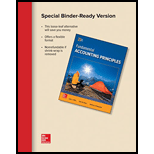
Concept explainers
Purchases Journal:
It is the journal where all the purchase on accounts or credit purchase of merchandise, supplies, equipment etc. are recorded.
Cash Disbursements Journal:
The journal where all the cash payments are recorded is called a cash payment journal like cash purchases of equipment, supplies, inventories and payment to creditors.
General Journal:
The transactions which are not recorded in the special journals namely, sales journal, purchase journal, cash receipt journal, and cash disbursement journal are recorded in the general journal.
Accounts Payable Subsidiary Ledger:
It is a subsidiary ledger which shows the details of the credit transactions from a particular creditor. The details consist of amount of money paid to the creditor and owed to the creditor.
Schedule of Accounts Payable:
A schedule of accounts payable is a summary of accounts payable during a particular period. It shows the amount of money owed by the company to the creditors.
To determine:
1. Preparation of purchases journal, cash disbursements journal and general journal. Journalize the transactions that should be recorded in the purchases journal, cash disbursements journal and general journal.
2. Prepare the general ledger accounts and accounts payable subsidiary ledger accounts.
3. Verify the amounts that should be posted as individual amounts from the journals have been posted. Foot and crossfoot the journals and make the month-end postings.
4. Preparation of
Want to see the full answer?
Check out a sample textbook solution
Chapter 7 Solutions
Loose Leaf for Fundamental Accounting Principles
- Please provide the solution to this general accounting question with accurate financial calculations.arrow_forwardCan you solve this general accounting problem using accurate calculation methods?arrow_forwardI am looking for help with this general accounting question using proper accounting standards.arrow_forward
- Can you solve this general accounting question with the appropriate accounting analysis techniques?arrow_forwardPlease provide the answer to this general accounting question with proper steps.arrow_forwardCan you help me solve this general accounting question using valid accounting techniques?arrow_forward
- I am trying to find the accurate solution to this general accounting problem with the correct explanation.arrow_forwardCan you explain this general accounting question using accurate calculation methods?arrow_forwardI need help with this general accounting problem using proper accounting guidelines.arrow_forward

 AccountingAccountingISBN:9781337272094Author:WARREN, Carl S., Reeve, James M., Duchac, Jonathan E.Publisher:Cengage Learning,
AccountingAccountingISBN:9781337272094Author:WARREN, Carl S., Reeve, James M., Duchac, Jonathan E.Publisher:Cengage Learning, Accounting Information SystemsAccountingISBN:9781337619202Author:Hall, James A.Publisher:Cengage Learning,
Accounting Information SystemsAccountingISBN:9781337619202Author:Hall, James A.Publisher:Cengage Learning, Horngren's Cost Accounting: A Managerial Emphasis...AccountingISBN:9780134475585Author:Srikant M. Datar, Madhav V. RajanPublisher:PEARSON
Horngren's Cost Accounting: A Managerial Emphasis...AccountingISBN:9780134475585Author:Srikant M. Datar, Madhav V. RajanPublisher:PEARSON Intermediate AccountingAccountingISBN:9781259722660Author:J. David Spiceland, Mark W. Nelson, Wayne M ThomasPublisher:McGraw-Hill Education
Intermediate AccountingAccountingISBN:9781259722660Author:J. David Spiceland, Mark W. Nelson, Wayne M ThomasPublisher:McGraw-Hill Education Financial and Managerial AccountingAccountingISBN:9781259726705Author:John J Wild, Ken W. Shaw, Barbara Chiappetta Fundamental Accounting PrinciplesPublisher:McGraw-Hill Education
Financial and Managerial AccountingAccountingISBN:9781259726705Author:John J Wild, Ken W. Shaw, Barbara Chiappetta Fundamental Accounting PrinciplesPublisher:McGraw-Hill Education





